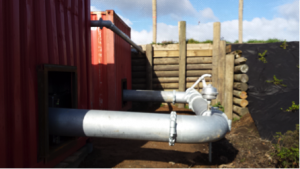Ngāi Tukairangi Trust Irrigation and Frost Protection Case Study

-
 Open Gallery
Open Gallery
- New Twin Diesel Pump stations and suction lines
-
 Open Gallery
Open Gallery
- New Pond Suction Pipe
-
 Open Gallery
Open Gallery
- Bore Pump Station
Outcome:
Ngai Tukairangi Trust work has been a large project spanning 11 years. The orchard has 48 ha of Kiwifruit located on the Matapihi Peninsular near Tauranga in the Bay of Plenty.
Brief:
AgFirst Engineering was first engaged by the Trust back in 2004 to design and implement irrigation plus frost protection on their B blocks. This was for approximately 13ha of kiwifruit using a combination of Nelson R 2000, R10 and R5 sprinklers. A total of 12 automatic valves were required, 2 of which serviced some small avocado areas.
A 4000 m³ pond was constructed for storing frost protection water, with a dedicated 150mm Pond filling line to allow a number of 100 mm boreholes and one 150mm hot water (geothermal bore) to fill the pond.
Background:
The Challenge the client faced
In 2015 a 13,000m3 water storage pond was constructed and lined with an HDPE liner for Frost fighting & irrigation. The work included a twin diesel pump station for flows up to 800m3/hr including a web based control system, which allows the operator to view the system operation in real time. This also allows the operator to remotely monitor, make changes and program the irrigation system. Field controllers are linked by fibre optic cable to the main controller back at the office block. Also in 2015 was the completion of the dual purpose R 10 sprinkler system to all of the kiwifruit in the A blocks.
The key challenge for this project was to find sufficient water for frost protection. The proximity of the orchard to the greater urban area of Mount Maunganui and Tauranga meant that it would be difficult to obtain a resource consent to use frost fans due to noise pollution. Initially frost protection irrigation systems were implemented on the B blocks with a storage pond filling from a number of existing boreholes. Then the 150mm geothermal borehole was redeveloped to provide sufficient water for frost fighting on a small section of the A blocks using a pulsing program. In 2010 a 250mm borehole was developed on the C block which was able to sustainably produce 100 m3/hr. This allowed the C block to be irrigated as one area under a frost event or irrigated in two zones under light frost and during summer, and to service other areas by providing water for filling storage ponds. Recently with all of the irrigation development now complete, a total water requirement investigation has been implemented and a report submitted to the local Regional Council with specific requests to update existing water take consents for all of the borehole water sources to meet present requirements.
Conclusion:
Ngai Tukairangi Trust has been able to utilize AgFirst Engineering for all the facets of irrigation and water development. In addition, AgFirst Engineering has been able to assist with staff training and preparation of total water requirement report for The Bay of Plenty Regional Council. This has allowed the Trust to work towards optimal use of irrigation systems and water resources.
The Trust plans to continue working with Ag First Engineering and has engaged them to prepare CAD maps and a System Operation Manual to ensure that current and future staff can be well-versed in understanding and operating the various parts of their Irrigation, Monitoring and Control systems.
With such a large and spread out area of kiwifruit blocks, water development, pumping systems, main lines, valve stations and the control system required good technical design, creativity and functionality. Apart from irrigation design and consultancy the Trust required other services such as project management, preparation of irrigation budgets, preparing consent applications, liaising with regional authorities, organizing contractors and subcontractors including the installation work. AgFirst Engineering was able to provide a total service for the Trust to ensure that any complicated or technical hurdles from such a large project would be managed and overcome and to meet each challenge as it was presented. One of the key outcomes has been the ability to pump bore water to either storage pond, to provide maximum flexibility, and to ensure efficient use of the limited water resources.
